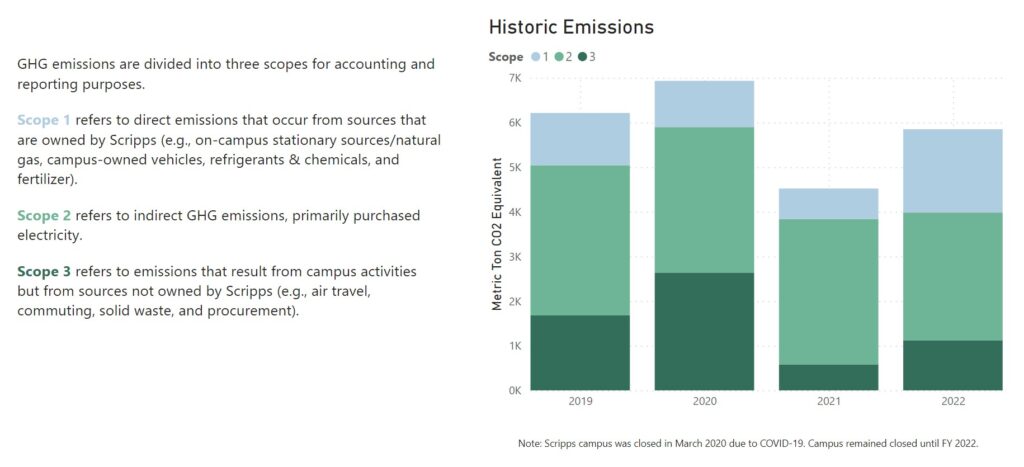Juliette Des Rosiers ’26
Copy Editor Intern
After a flooded February and a snowy March, the “It may be d’rough’t but it’s necessary. Conserve.” signs seem almost comical. However, many Scripps students are aware that these climatic events are not reparations but actually implications of the climate crisis.
Every day, we must ask ourselves how we can improve our impact on environmental well-being, whether it be sailor showers or veganism. As a community and an institution, how does Scripps College critically assess its environmental practices and improve its carbon footprint?
The 2022 Sustainability Report presents a breakdown of the sustainability practices and initiatives of Scripps through the fiscal and academic year of 2021-22. This information was collated and the report was designed by Sustainability Coordinator Lauren Ng with assistance from Scripps students Anna Huf ’25 and Sydney Hamel ’25.
The report uses 2019 as a reference date for comparing records of sustainability data since it provides the oldest, most accurate, pre-pandemic data. After the 2020 data set, energy use and emissions shifted due to elements such as increased air conditioning for ventilation or decreased travel from studying abroad. Therefore, until a “new norm” is established, 2019 is used as a baseline for carbon neutrality goals of which there is no goal date yet.
The report is comprised of 10 pages exploring the layers of sustainable operations and programs at Scripps College. Each page contains a summary, empirical graphs, and key recommendations on how to improve, starting with the Climate page.
The Climate page reports that, overall, Scripps’ carbon emissions have decreased since the baseline in 2019. This is promising and guides the report to the primary recommendation of setting an official carbon-neutral date by which Scripps College will have offset its emissions to similar levels as 2019.
The Historic Emissions bar graph (pictured) introduces the value to scopes that define Scripps’ emissions data. Scope 1, 2, and 3 refer to different sources of emissions, each broadening Scripps’ influence respectively. For instance, Scope 1 refers to the emissions of on-campus operations while Scope 2 observes outsourced elements such as purchased electricity, and Scope 3 tracks emission sources not owned by Scripps but still used by the college, such as travel or commuting.
These Scopes are evidently important to include, as the largest contributor towards emissions was purchased electricity. This does not belong to the immediate Scope 1, but Scope 2. Surprisingly, however, Scripps could still halve its carbon emissions if it switches to completely renewable electricity, as evidenced by the Energy section on page 3.
Scripps College has increased its energy usage across almost all fronts since 2019, reiterating the importance of incorporating sustainability into administrative planning on campus operations. The 30% increase in gas usage is concerning and, although not completely studied, likely attributed to a demand for heating. Therefore, if the college switched to electric or mixed sources, the environmentally detrimental energy use could be offset and carbon emissions due to natural gas would decrease.
In light of the infamous California drought and student concern over water use on the Scripps Campus, it is disappointing the limited data available to the Sustainability Committee on water usage. The report states 44 million gallons of water were used on campus, similar to the 41 million gallons used in 2019.
The committee is looking to find the right balance between upholding the administration’s desired aesthetic for a green-lawned Scripps campus while still nurturing responsible water practices. An important goal is the incorporation of submetering, or, the division of areas when measuring water use.
Additionally, recent drought restrictions as well as student input via SAS committees have influenced changes in water use. There is motivation to increase funding for water conservation program planning, such as the recently implemented drip irrigation.
The Sustainability Report also covers data on solid waste patterns. The data is based on the City of Claremont, which reports recyclables based on estimated average pick-up weights and solid and green trash by mass. The report scrutinizes the 64% increase in landfill waste compared to 2019 and hypothesizes that this trend is likely due to the mandatory disposables used after the pandemic began.
The Sustainability Report highlights the ecological diversity of flora on campus that improves the college’s environmental footprint. For instance, through the use of native, drought-friendly, and pollinator-friendly plants. In addition to the in-the-ground benefits, all the landscaping equipment is electric and the report mentions the introduction of new energy-collecting devices to improve environmental monitoring and, eventually, reporting.
The report is limited due to its exclusion of the W.M. Keck Science Center. Although Keck is considered a collaboration between CMC, Pitzer, and Scripps, dividing the energy, water, and waste habits of the center between the three schools is a challenge.
Additionally, Keck records these categories separately from the schools, making it difficult to streamline and process the data alongside Scripps’ methodology. Therefore, it will be interesting not only to observe how the addition of the Nucleus in 2024 will affect the sustainability practices of Scripps but also how they will choose to record it.
The report also includes summaries of sustainability-related initiatives at Scripps College. It delves into the on-campus internships, research, and capstones that students participate in.
Lastly, the report spotlights the community-based on-campus sustainability initiatives. These included the CLORG Scripps Farm and yearly Scripps Scrapps. There is also a spotlight on the beloved olive harvesting tradition and the college-sponsored Sustainability Fair, the latter of which is returning on April 21.
The Scripps Sustainability Committee is enthusiastic about student involvement in sustainability initiatives, whether that be employment with Scripps Scrapps, joining a SAS committee, reporting ways to improve water conservation to facilities, or simply attending a sustainability event. The Scripps Sustainability Report will shortly be available to students by email, so keep your eyes open for it!
Image Source: Scripps College



